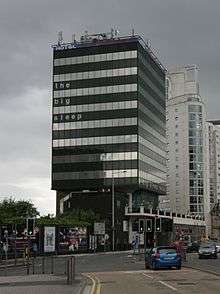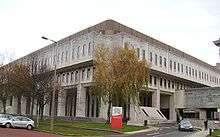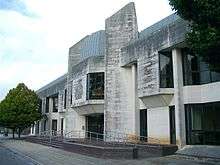Alex Gordon (architect)
Sir Alexander John Gordon, CBE (25 February 1917 – 12 July 1999) was a Welsh architect. Born in Ayr, Scotland, he was brought up and educated in Swansea and Cardiff. After World War II he designed several major buildings in Cardiff and Swansea, and from 1971 to 1973 he served as president of the Royal Institute of British Architects.[1] In 1974 he summarised the needs of new architecture as 'Long life, loose fit, low energy'.
Sir Alex Gordon | |
|---|---|
| Born | 25 February 1917 Ayr, Scotland, UK |
| Died | 12 July 1999 (aged 82) St Hilary, Vale of Glamorgan, Wales, UK |
| Nationality | British |
| Occupation | Architect |
| Practice | Alex Gordon & Partners |
| Buildings |
|
Biography

Gordon was born in Ayr, Scotland, the son of John Tullis Gordon (b. 1884), a telegraph engineer, and Euphemia Baxter Borrowman Gordon, née Simpson (1890–1942). In 1925 the family moved to Swansea.[1]
Gordon attended Swansea Grammar School, where his contemporaries included the poet Dylan Thomas, with whom he produced the school magazine, the composer Daniel Jones and the art critic Mervyn Levy.[2] He lived in South Wales for the rest of his life, for many years at Llanblethian in the Vale of Glamorgan.
He was an enthusiastic art collector, and bequeathed 32 paintings to the Glynn Vivian Art Gallery, Swansea, including works by Marc Chagall, Augustus John, Kyffin Williams, Barbara Hepworth, Ben Nicholson and Elizabeth Frink and a portrait bust of himself by Ivor Roberts-Jones.[3][4]
He retired in 1982, but retained a consultative role until 1988.
He died in St Hilary, Vale of Glamorgan on 23 July 1999. He was unmarried.[5]

Training
Gordon became a trainee architect in the Swansea Borough Architect's Department in 1935, and studied part-time for the RIBA intermediate examination, which he passed before the outbreak of the Second World War.[1] In 1936, while a trainee, he won the Lord Mayor of Cardiff's competition for the design of street decorations to celebrate the coronation.[2] During World War II he served as a major in the Royal Engineers, serving in Palestine where he worked on large-scale construction projects.[1] After leaving the Army, he studied at the Welsh School of Architecture in Cardiff, and was awarded a diploma with special distinction in 1948.[1]
Professional life
In 1949 Gordon entered into partnership with Thomas Alwyn Lloyd (1881–1960), forming T. Alwyn Lloyd and Gordon. Initially the practice worked on public housing and housing for the Forestry Commission.[2]
In 1949 he was appointed consultant architect to the Wales Gas Board, for which he designed a new headquarters, Snelling House, Cardiff (1966). This eight-story office block was the first of many large buildings that he designed.
After Alwyn Lloyd's death in 1960, Gordon established Alex Gordon and Partners with Alun Roberts and David Humphreys. The business expanded, and had ten partners by 1972.[2]
Gordon was visiting professor at the Bartlett School of Architecture, University College London[1]
Gordon was elected president of the South Wales Institute of Architects in 1967. He was active in the RIBA and served as its president from 1971 to 1973.
Buildings

- 1955 University Sports Pavilion, Cardiff (Awarded RIBA Bronze Medal)
- 1966 Cyncoed Methodist Chapel, Cardiff
- 1966 Snelling House, Cardiff. Headquarters of Wales Gas, now the Big Sleep hotel.[8]
- Mid-1960s Staff housing Atlantic College, St Donats
- 1967 Cement and Concrete Association Training Centre, Fulmer Grange, Slough[9]
- 1968 Churchill House, Cardiff
- 1970 Telephone Exchange Building, Swansea[10]
- 1970 Cardiff University School of Music[11]
- 1971 Sherman Theatre, Cardiff[12]
- 1972 Mathematics Building, Cardiff University
- 1973 Students' Union Building, Cardiff University
- 1978 Transport House, Transport and General Workers' Union building, Cardiff
- 1979 Welsh Office, Cathays Park, Cardiff, now known as Crown Building 2
- 1981 Princess of Wales Hospital, Bridgend
- 1988 Crown Court, Swansea
Public committees
- Cardiff Development Corporation
- Design Council
- Royal Fine Art Commission
- University Grants Committee
- Welsh Arts Council
Awards and honours
- OBE (1967)
- Honorary LL.D, University of Wales (1972)[5]
- CBE (1974)
- Knighted (1988)
- Honorary fellow, University College Cardiff (1989)[13]
- Honorary fellow, American Institute of Architects
- Honorary fellow, Royal Architectural Institute of Canada
- Honorary member, Bund Deutscher Architekten (Association of German Architects)[14]
References
| Wikimedia Commons has media related to Alex Gordon (architect). |
- Foyle, Andrew (2011). Oxford Dictionary of National Biography. Oxford University Press. Retrieved 19 February 2014.
- Hutchinson, Maxwell (29 July 1999). "Obituary – Alex Gordon – Architect with a prophetic vision of sustainability and low energy". The Guardian. Retrieved 19 February 2014.
- "Bonhams to hold its first major exhibition of Welsh painting in Cardiff". Bonhams Auctioneers. 5 March 2013. Retrieved 19 February 2014.
- "A Passion For Art – 50 Years of Friends of the Glynn Vivian". 6 March 2008. Retrieved 19 February 2014.
- Stephens, Meic (28 July 1999). "Obituary: Sir Alex Gordon". The Independent. Retrieved 19 February 2014.
- Murray, Gordon (11 October 2011). "Stirling Prize Criticism : The Persistence of the Absurd". e-architect. Retrieved 19 February 2014.
- "Associated Arctitects". Archived from the original on 27 February 2014. Retrieved 19 February 2014.
- "Snelling House, Churchill Way, Cardiff". RIBA. Retrieved 19 February 2014.
- "Training in Concrete" (PDF). Concrete Quarterly. Cement and Concrete Association (73): 13–21. April–June 1967. Archived from the original (PDF) on 23 February 2014. Retrieved 19 February 2014.
- "Telephone exchange extension". Retrieved 19 February 2014.
- "Alun Hoddinott CBE (1929–2008)". Cardiff University. Archived from the original on 23 September 2013. Retrieved 19 February 2014.
- "Sherman Thratre". Retrieved 19 February 2014.
- "Honorary Fellows – Previous Recipients". University of Cardiff. Archived from the original on 25 February 2014. Retrieved 19 February 2014.
- "Honorary Members". Bund Deutscher Architekten. Archived from the original on 23 March 2013. Retrieved 5 March 2014.